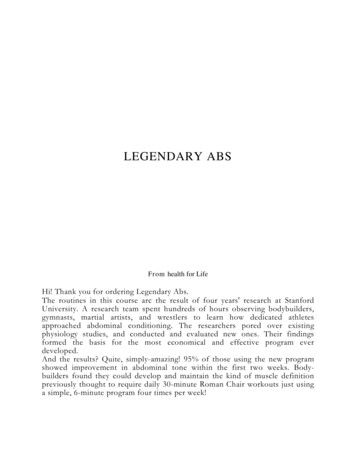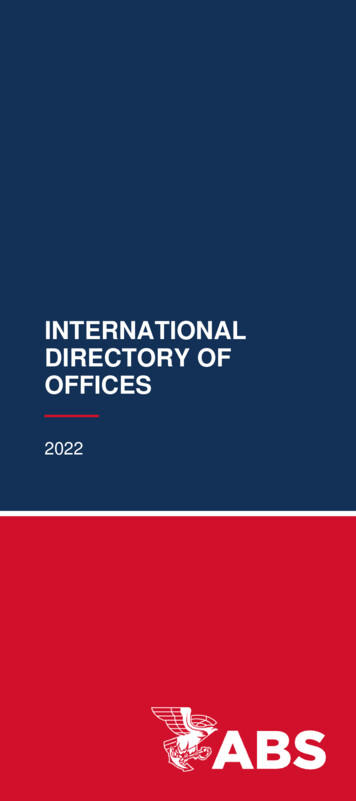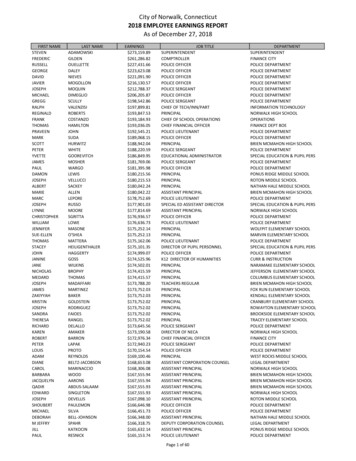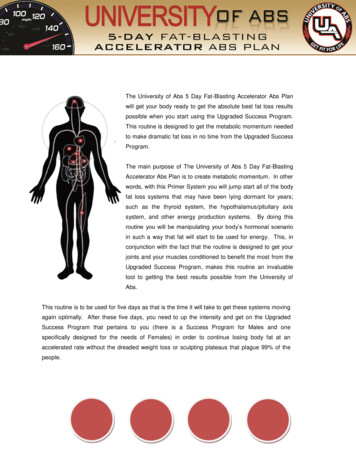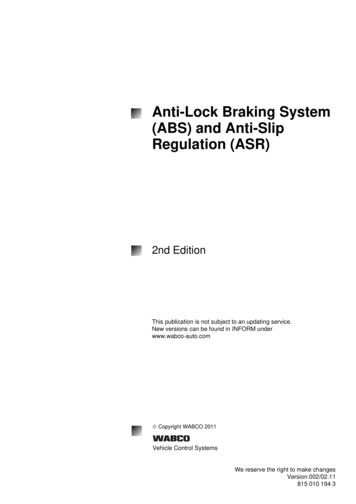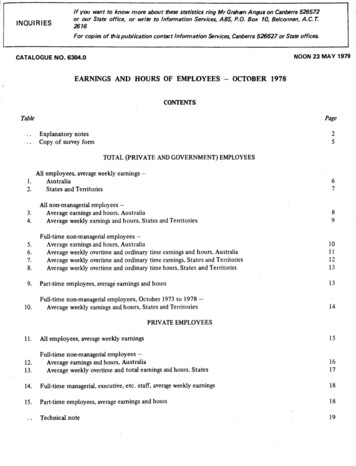
Transcription
if you want to know more about these statistics ring Mr Graham Angus on Canberra 526572INQUIRIESor our State office, or write to Information Services, ABS, P.O. Box10, Belconnen, A.C.T.2616For copies of this publication contact Information Services, Canberra 526627 or State offices.NOON 23 MAY 1979CATALOGUE NO. 6304.0EARNINGSANDHOURSOF EMPLOYEES— OCTOBER1978CONTENTSTablePageExplanatory notesCopy of survey form25TOTAL (PRIVATE AND GOVERNMENT) EMPLOYEESAll employees, average weekly earnings —Australia2.States and Territories67—3.4.All non-managerial employees —Average earnings and hours, AustraliaAverage weekly earnings and hours, States and Territories89Full-time non-managerial employees gs and hours, Australiaweekly overtime and ordinary time eamings and hours, Australiaweekly overtime and ordinary time earnings, States and Territoriesweekly overtime and ordinary time hours, States and Territories10111213Part-time employees, average earnings and hours13Full-time non-managerial employees, October 1973 to 1978 —Average weekly earnings and hours, States and Territories14PRIVATE EMPLOYEES11.All employees, average weekly earnings1512.1613.Full-time non-managerial employees —Average earnings and hours, AustraliaAverage weekly overtime and total earnings and hours, States14.Full-time managerial, executive, etc. staff, average weekly earnings1815.Part-time employees, average earnings and hours18Technical note1917
EXPLANATORY NOTESCoverageThe survey covered stratified random samples tionThis bulletin contains the results of a sample.survey of weekly earnings and hours’ which wasconducted in respect of the pay-period which included16 October 1978. Some comparative figures are alsoshown for October 1973 to 1978 (see Table 10).Preliminary estimates were published in Earnings andHours of Employees, October 1978(6303.0) issued on 21 December 1978.2.non-government hospitals (not subject to payroll tax)and other private employers.Survey design5.Although the sample was not designed toprovide estimates of the numbers of employeesrepresented, it has been calculated that the survey wasrepresentative of approximately 2,647,000 male and1,432,000 female wage and salary eamers, of whom1,671,000 males and 905,000 females were in yees by category are shown in the table below.(Preliminary)In general, where an establishment was closeddown for part or the whole of the specified pay-period,or operations were seriously curtailed by an industrialdispute, breakdown, fire, etc., the employer was askedto supply particulars of earnings and hours for theprevious normal pay-period. A copy of the form used inthe 1978 survey is shown on page 5.Scope3.All wageand salary earners wereReliability of the estimates6.Since the estimates are based on informationobtained from a sample of employers they are subject tosampling variability; that is, they may differ from thefigures that would have been produced if all employershad been included in the survey. The extent of the detailpublished has been determinedafter consideringestimated measures of sampling variability. For moredetails on the reliability of the estimates see theTechnical Note on page 19.representedexcept—members of the defence forces,employees in agriculture,employees in private households employing staff,waterside workers employed on a casual basis,persons employed by private employers (other thanhospitals) not subject to payroll tax.At the timewas payablepaying more( 100,000 aGovernmentIndustry classification7.Industry is classified according to the AustralianStandard Industrial Classification (ASIC) described inof the selection of the sample, payroll taxby employers in the States and Territoriesthan 60,000 a year in wages and salariesyear in Queensland). In general, ustrialClassification(Preliminary Edition) 1969, Vol. 1. The table on page 3shows details of the ASIC sub-divisions used in thesurvey and abbreviated descriptions used in some tables.benevolentinstitutions,publichospitals andothersimilarorganisations are specifically exempted under theAustralian and State Payroll Tax Acts.Approximate Percentages of Employees by Category(Per cent)Private employeesMalesCategoryFull-time managerial, executive, etc. staffFull-time non-managerial employees — AdultsJuniorsPart-time employees —AdultsJuniorsTotal employees represented by sample&v. idsMBRARYraWwW.14 dhe 1679PONA?.«;FemalesTotal (privateand .8100.0100.0100.0100.0
ASIC CodeSubDivisiondivisionCTitleAbbreviated description usedManufacturing —21—22 Food, beverages and tobacco23,24 Textiles; clothing and footwear26 Paper and paper products, printing and publishingPaper, printing, etc.27 Chemical, petroleum and coal products29 Basic metal products31,33Fabricated metal products; otherFabricated metal products; other industrial machinery andequipment and household appliances32 Transport equipment25,28,34 Other (a)Non-manufacturing industries —MiningElectricity, gas and watermow“TlG, Hmachinery, etc.Construction46—47 Wholesale trade48 Retail tradeTransport and storage; communicationJFinance, insurance, real estate and business servicesJ,K(b)Public administration and defence (b); community servicesA, L(c)Other industries (c) (forestry and logging, fishing and hunting,Finance, business servicesPublic administration, etc.Otherentertainment, recreation, restaurants, hotels andpersonal services)Total (b)(c)(a) Includes wood, wood products and furniture (sub-division 25); glass, clay and other non-metallic mineral products (sub-division 28);leather, rubber and plastic products and manufacturing not elsewhere classified (sub-division 34). (b) Excludes defence forces. (c) Excludesagriculture and services to agriculture (sub-divisions 01 and 02) and private households employing staff (sub-division 94).Comparability of results8.Similar surveys covering private employees onlywere conducted in October in a number of years prior to1972. In 1972, the coverage of the surveys wasexpanded to include private employees in the employees in non-government hospitals not subject topayroll tax and employees of Australian, State and localgovernment authorities. Because of the introduction ofthe AustralianStandard IndustrialClassification,estimates by industry for 1974 and later years are notdirectly comparable with those obtained from surveysprior to 1974.Definitions9.Employees refers to male and female wage andsalary earners who received pay for the pay-period whichincluded 16 October 1978. (see paragraph 3, page 2.)10.Private employees are employees of privateemployers subject to payroll tax and employees ofnon-government hospitals not subject to payroll tax.11.Adult employees comprise all employees 21years of age and over, and employees under 21 years ofage who are paid at the adult rate for their occupation.Junior employees are all other employees under 21 yearsof age.12.Full-time employees are those employees whoordinarily worked 30 hours or more a week. Includedarefull-time employeeson short-time, full-timeemployees who began or ceased work during thepay-period, and full-time employees on paid annualleave, paid sick leave, long service leave and paidholidays taken during the specified pay-period. Someemployees (e.g. air crews, teachers, university lecturers),although paid for a weekly attendance of less than 30hours, wereclassified as full-time if they workedthenormal scheduled hours for a full week.13.Part-time employees ate those employees whoordinarily worked less than 30 hours a week. Employeeson short-time who normally worked 30 hours or more aweek were classified as full-time loyees were defined to include minor supervisoryemployees, leading hands, clerical and office staff as wellas ordinary wages employees. They exclude managerial,executive, professional and higher supervisory staff who,for private employees, were not further defined. sional and higher supervisory staff were generallydefined as those employees (i) who were ineligible toreceive payment for overtime, or (ii) who, althoughsubject to payment for overtime, were in charge of a
nt(or establishments).The basis ofallocation of employees to these two categories mayhave varied between individual private employers andbetween employers in the private and governmentsectors, with consequent effects on survey results. Forsome occupations in government employment, such asschool teachers and doctors, there is no general paymentfor overtime. In these cases, managerial, etc. staff weredetermined according to the degree of supervisionexercised or in relation to the pay structure of associatedadministrative employees.20.Ordinary time hours refers to award, standardor agreed hours of work. It includes stand-by orreporting time which are part of standard hours of work,and that part of paid annual leave, paid sick leave andlong service leave taken during the pecified pay-period.Related publications21.Users may also wish to refer to the followingpublications which are available on request :EarningsandHoursof Employees,October(Preliminary) — (6303.0).15.Weekly earnings refers to gross earnings beforetaxation and other deductions have been made. Itcomprises overtime earnings (see paragraph 16) andordinary time earnings (see paragraph 17). WhereEarnings and Hours of Employees, Distribution andpayments are made other than on a weekly basis, e.g.Weekly Earnings of Employees (Distribution) —(6309.0) (Preliminary) and Final Bulletin (6310.0),containing results of household interview surveysconducted annually in August.salary paid fortnightly or monthly; paid annual or otherleave taken during the specified pay period; periodicalpayments under incentive, piece-work, profit-sharing,etc. schemes; commissions; annual or periodical bonuses;etc., one week’s proportion of such paymentsincluded. Retrospective payments are excluded.16.Overtime earningsweekly earnings (as definedpaid for in excess of award,work. Overtime earningsmanagerial, etc. staff.arerefers to that part of grossabove) attributable to hoursstandard or agreed hours ofwere not reported for17.Ordinary time earings refers to that part ofgross weekly earnings (as defined above) attributable toaward, standard or agreed hours of work. Included inrelation to these hours are shift allowances, penaltyrates, commissions, bonuses and incentive payments, andone week’s proportion of payments for annual and otherleave taken during the specified pay-period.Composition (Preliminary) — (6305.0), and FinalBulletin (6306.0) — sample survey conductedannually in May.Average Weekly Earnings — (6301.0) (Preliminary)and Final Bulletin (6302.0) — quarterly.Income Distribution Part 1, 1973-74 (6502.0), Part2 (6503.0) and Part 3 (6504.0) — sample surveyconducted in respect of 1973-74.Wage Rate Indexes (Preliminary ) (6311.0) and WageRates (6312.0) — monthly.22.All publications produced by the ABS arelisted in Catalogue of Publications (1101.0) which isavailable free of charge from any ABS office.Symbols and other usages* Subject to sampling variability too high formost practical uses. See paragraph 6 above.Not applicable.18.Weekly hours paid for refers to the hours forwhich payment was made. It comprises overtime hours(see paragraph 19) and ordinary time hours (seeparagraph 20). For employees paid other than weekly,hours were converted to a weekly basis. For employeeswho began or ceased work, or were absent without payfor any reason during the specified pay-period, only thehours actually paid for were included. Where agreedhours of work were less than award hours, hours werebased on agreed hours. Hours of work were not reportedWhere figures have been rounded, discrepanciesmay occur between sums of the component items andtotals.NOTE.The estimates of average weekly earnings arerounded to the nearest 10 cents, those ofaverage weekly hours paid for to the firstdecimal place, and those of average hourlyearnings to the nearest cent.for managerial, etc. staff.19.Overtime hours refers to hours in excess ofaward, standard or agreed hours of work.A. R. BAGNALLActing Australian Statisticiant
.3.pageonSee CONFIDENTIAL1978Particulars are to be supplied for all employees included on the Australian Capital Territory Pay-roll Tax return of theorganisation, company or firm named in the address box on page 3 and who received pay for the pay-period whichincludedNumber(a) Managerial,EMPLOYEESexecutive,(ie. those who ordinarilymore a week}—professionalandworkhigher supervisoryTotal Gross Weekly Earnings (i.e. total forTota! Weekly Man-hours Paid For (i.e.total for one week for all employees in eachcategory — see instructions 8 and 9)ToMALEEMPLOYEESeras:30 hours orstaff1978.5)InstructionFULL-TIME MALE(see instruction 6)ofEmployees(seeParticulars (see instruction 2) 6 Octoberl) nearestOrdinaryone week for all employees in each category—gseehourTimeinstructionsTo nearest10 and 11)dollarOvertimeTotaliOfficeuse onlyTotal Officeuse onlyiiAdults(b) All other full-time employees (include minor supervisory(see instruction 4)employees, leading hands, clerical and office staffas well as OYEESMALE(:e. those who(see instruction 7)aswellas ordinarywagesclericalJuniorshigher supervisoryminor(b) All other full-time employees (includehands.7ft18 21‘2ce.Ora aneor more a week}—executive. professional andleadingl(ce. those who ordinarily work 30 hoursEMPLOYEES(see instruction 6)employees,Adults(see instruction 4)a week)FULL-TIME FEMALE(a) Managerial.workordinanlyless than 30 alse ie;iloeOaiilOfficeuse only l :iit30Total 'y31337 eames32(see instruction 4)78(eaeemployees)JuniorsPART-TIME FEMALE(see instruction 7)EMPLOYEES(ie., those who ordinarily work Adultsfess than 30 hours(see mstruction 4) ATTTTETTTTTTTTTEa week)JuniorsTOTALFEMALEPlease commentEMPLOYEES briefly on any unusual features affecting this return (e.g. low or high earnings and hours) and any major differences between this return and your returnshould be contactedPersonwhoNatureof employer'sactivityif any queries arise regarding— NAMEthis asenessneneaeseensetiaess TelephoneMTs. cccscccsceseceeseseeeereeeMiss0.0.0.0 00.0. cccccseecesesees eee ceseeeeesecsece ceeceseeseeesee cess saeneeeete ceaeeaeesBLOCK LETTERSSignaturefor last year (if any).nts0 WesiolieicbeiseottstNumbet .::60STD Code
TOTAL (PRIVATE AND GOVERNMENT) EMPLOYEESTABLE 1. AVERAGE WEEKLY EARNINGS, ALL EMPLOYEES, INDUSTRIES, OCTOBER 1978@)ManufacturingMetal products, machinery and equipmentFood,Textiles;clothingbeveragesandand tobacco footwearMalesAdultsJuniorsFull-time e ing,ete.and coalproductsmetalproductsTotalother mach- Transportinery, etc. 224.10112.20219.80225.50119.70207.00— 6.50244.70128.90207.40218.80106.90206 10.00202.50209.80118.00204.90213.80113.90 96.20205.40110.70203.40211.50112.60Full-time 100.90115.90131.30128.40108.10iprreerrNon-manufac Finance,adminis-Publicnonmanufac t-allFull-time e e employeesAdultsJuniorsTotalgas 235.60243.60129.3023430247.70127.40258.80- 60176.70113.90170.10180.00108.30 141.50162.30 6102.30181.20189.80§ 0219.80115.80 alSRee-
TABLE 2, AVERAGE WEEKLY EARNINGS, ALL EMPLOYEES, STATES AND TERRITORIES, OCTOBER 1978( 0115.40106.90119.50(a)(a)112.20Full-time .80 )261.90268.10(a)203.40211.50112.60J FemalesAdultsJuniorsFull-time e sJuniors 5.1098.30142.80156.0095.60 ll-time ll-time e employeesAdultsJuniorsTOTAL ALL INDUSTRIESMalesAdultsJuniorsFull-time employees- AdultsJuniorsFemalesAdultsJuniorsFull-time e 88.00110.20195. 6.90212.90223.40116.80ttnrrrrr et(a) Information not available because of relatively few employees reported.
TABLE 3. AVERAGE EARNINGS AND HOURS, ALL NON-MANAGERIAL EMPLOYEES, INDUSTRIES,OCTOBER 1978ManufacturingMetal products, machinery and equipmentTextiles;Food,clothingbeveragesandand tobacco footwearPaper,printing,ete.Chemical,petroleumand cts;other mach- Transportinery, etc. 0102.20. 182.30201.90210.70 4.68AVERAGE WEEKLY EARNINGS ( AGE WEEKLY HOURS PAID 7.637.538.940.0AVERAGE HOURLY EARNINGS ( 3.295.335.455.633.25 nu 5.70156.60160.10- 102.60111.90113.3093.80131.50TotalnonTotal .manufactalluringindustriesAVERAGE WEEKLY EARNINGS ( .125.265.472.994.474.752.995.00AVERAGE WEEKLY HOURS PAID 36.3- 38.331.439.5iaAVERAGE HOURLY EARNINGS ( 35.17 2canmma4.945.102.844.434.582.914.68a
TABLE 4. AVERAGE WEEKLY EARNINGS AND HOURS, ALL NON-MANAGERIAL EMPLOYEES, INDUSTRIES,STATES AND TERRITORIES, OCTOBER 1978N.S.W.Vie.OldSA.W.A.Tas.N.T.ACT.Aust.AVERAGE WEEKLY FARNINGS ( 350132.90142.20 2.40176.30MANUFACTURING LEaeae 39.50 20«191.40«2147.10195.30 086.30 20»243.40231.80206.60249.40242.20 —«.216.50130.00 —«-101.40 —S«106.50178.30{67.50146.30184.90176.10156.00 —«:107.3085.4098.30220.60 . 203.80 181.50TOTAL ALL 109.80139.50152.0095.20180.50«194.60 203.70 7.80220.00232.30 .1085.8098.90204.90 —-183.00AVERAGE WEEKLY HOURS PAID .635.238.238.634.430.630.630.435.0TOTAL ALL .632.332.133.036.5(a) Information not available because of relatively few employees reported.38.939.335.731.231.131.235.9
10TABLE 5. AVERAGE EARNINGS AND HOURS, FULL-TIME NON-MANAGERIAL EMPLOYEES, INDUSTRIES, OCTOBER 1978RRManufacturingMetal products, machinery and equipmentTex tiles;Food,clothingbeveragesandand tobacco footwearPaper,printing,ete.Chemical,petroleumand cts,other mach- Transportinery, etc. 9.439.241.041.241.340.238.938.939.140.74L 2.664.564.925.112.873.964.082.764.69AVERAGE WEEKLY EARNINGS ( RAGE WEEKLY HOURS PAID 9.239.239.240.8AVERAGE HOURLY EARNINGS ( lectricity,gas age;communicationAVERAGE WEEKLY s( )Males293.70 230.00 .212.70 3 202.80) 171.30 224.90 .203.70 50217.40177.50213.20180.60emNNrlAVERAGE WEEKLY HOURS PAID .139.6eeerevesHOURLY EARN
9. Part-time employees, average earnings and hours 13 Full-time non-managerial employees, October 1973 to 1978 — 10. Average weekly earnings and hours, States and Territories 14 PRIVATE EMPLOYEES 11. All employees, average weekly earnings 15 Full-time non-managerial employees — 12. Average earnings and hours, Australia 16 13.


